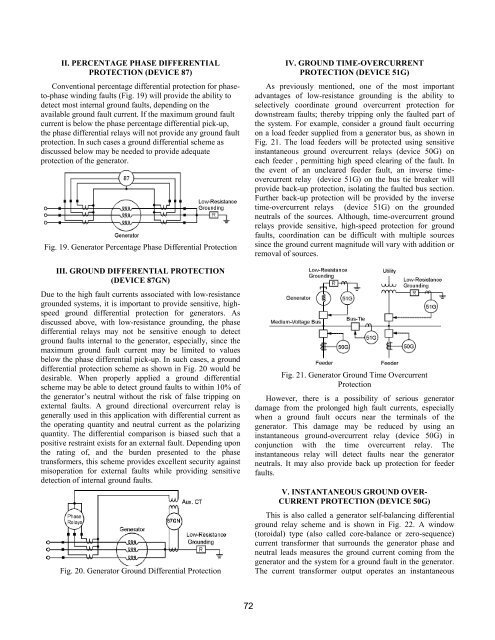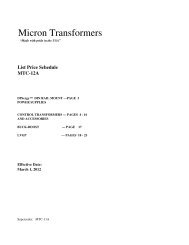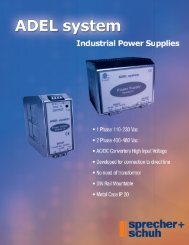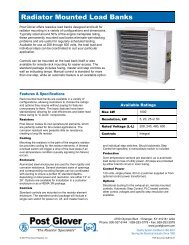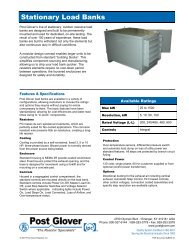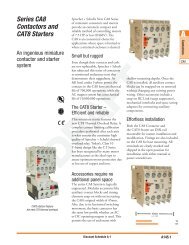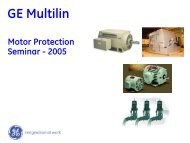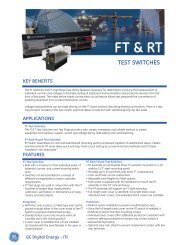IEEE Hybrid Grounding
IEEE Hybrid Grounding
IEEE Hybrid Grounding
You also want an ePaper? Increase the reach of your titles
YUMPU automatically turns print PDFs into web optimized ePapers that Google loves.
II. PERCENTAGE PHASE DIFFERENTIAL<br />
PROTECTION (DEVICE 87)<br />
Conventional percentage differential protection for phaseto-phase<br />
winding faults (Fig. 19) will provide the ability to<br />
detect most internal ground faults, depending on the<br />
available ground fault current. If the maximum ground fault<br />
current is below the phase percentage differential pick-up,<br />
the phase differential relays will not provide any ground fault<br />
protection. In such cases a ground differential scheme as<br />
discussed below may be needed to provide adequate<br />
protection of the generator.<br />
Fig. 19. Generator Percentage Phase Differential Protection<br />
III. GROUND DIFFERENTIAL PROTECTION<br />
(DEVICE 87GN)<br />
Due to the high fault currents associated with low-resistance<br />
grounded systems, it is important to provide sensitive, highspeed<br />
ground differential protection for generators. As<br />
discussed above, with low-resistance grounding, the phase<br />
differential relays may not be sensitive enough to detect<br />
ground faults internal to the generator, especially, since the<br />
maximum ground fault current may be limited to values<br />
below the phase differential pick-up. In such cases, a ground<br />
differential protection scheme as shown in Fig. 20 would be<br />
desirable. When properly applied a ground differential<br />
scheme may be able to detect ground faults to within 10% of<br />
the generator’s neutral without the risk of false tripping on<br />
external faults. A ground directional overcurrent relay is<br />
generally used in this application with differential current as<br />
the operating quantity and neutral current as the polarizing<br />
quantity. The differential comparison is biased such that a<br />
positive restraint exists for an external fault. Depending upon<br />
the rating of, and the burden presented to the phase<br />
transformers, this scheme provides excellent security against<br />
misoperation for external faults while providing sensitive<br />
detection of internal ground faults.<br />
Fig. 20. Generator Ground Differential Protection<br />
IV. GROUND TIME-OVERCURRENT<br />
PROTECTION (DEVICE 51G)<br />
As previously mentioned, one of the most important<br />
advantages of low-resistance grounding is the ability to<br />
selectively coordinate ground overcurrent protection for<br />
downstream faults; thereby tripping only the faulted part of<br />
the system. For example, consider a ground fault occurring<br />
on a load feeder supplied from a generator bus, as shown in<br />
Fig. 21. The load feeders will be protected using sensitive<br />
instantaneous ground overcurrent relays (device 50G) on<br />
each feeder , permitting high speed clearing of the fault. In<br />
the event of an uncleared feeder fault, an inverse timeovercurrent<br />
relay (device 51G) on the bus tie breaker will<br />
provide back-up protection, isolating the faulted bus section.<br />
Further back-up protection will be provided by the inverse<br />
time-overcurrent relays (device 51G) on the grounded<br />
neutrals of the sources. Although, time-overcurrent ground<br />
relays provide sensitive, high-speed protection for ground<br />
faults, coordination can be difficult with multiple sources<br />
since the ground current magnitude will vary with addition or<br />
removal of sources.<br />
Fig. 21. Generator Ground Time Overcurrent<br />
Protection<br />
However, there is a possibility of serious generator<br />
damage from the prolonged high fault currents, especially<br />
when a ground fault occurs near the terminals of the<br />
generator. This damage may be reduced by using an<br />
instantaneous ground-overcurrent relay (device 50G) in<br />
conjunction with the time overcurrent relay. The<br />
instantaneous relay will detect faults near the generator<br />
neutrals. It may also provide back up protection for feeder<br />
faults.<br />
V. INSTANTANEOUS GROUND OVER-<br />
CURRENT PROTECTION (DEVICE 50G)<br />
This is also called a generator self-balancing differential<br />
ground relay scheme and is shown in Fig. 22. A window<br />
(toroidal) type (also called core-balance or zero-sequence)<br />
current transformer that surrounds the generator phase and<br />
neutral leads measures the ground current coming from the<br />
generator and the system for a ground fault in the generator.<br />
The current transformer output operates an instantaneous<br />
72


